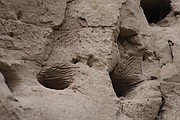Bank swallows populate area stream banks, bluffs
Kathleen Woodford Mineral Independent | Hagadone News Network | UPDATED 7 years, 6 months AGO
The skies are full of birds this time of year - swooping and diving as they catch insects for themselves and their hungry babies that fill nests throughout the mountains.
Bank Swallows tend to be especially busy with colonies that can contain 10 to 2,000 nests, according to the National Audubon Society. They are commonly found around natural bluffs, or eroding bank streams along rivers, streams and reservoirs. Insects they eat include bees, wasps, ants, butterflies and moths.
When building their nests, the male swallow begins to dig a burrow into the bank before he has a mate. Females then hover in front of burrows to choose a mate and his nest site. The male uses his small, conical bill as well as his feet and wings to dig burrows that lead to the nest chamber, which is about 25 inches deep. The female then builds the nest out of a flat mat of straw, grasses, leaves and rootlets. She lays between two to six eggs, which incubate for 13 to 16 days.
Unfortunately, the North American Bank Swallow is a species in decline, according to the North American Breeding Bird Survey. Between 1966 and 2014, the species declined 5 percent per year for a total decline of 94 percent.
It is estimated that there is a total population of 19 million birds. They spend 22 percent of their time in the U.S., 8 percent in Canada, and most winter in Mexico. They are listed as a state-threatened species in California, and a sensitive species in Oregon.
ARTICLES BY KATHLEEN WOODFORD MINERAL INDEPENDENT
Mineral County sends tax bill to Forest Service
The Forest Service will be receiving a property tax bill from Mineral County this year. County Commissioners Laurie Johnston, Roman Zylawy and Duane Simons signed the letter March 9 requesting property tax revenue for 2017. The “historic letter” as defined by Rep. Denley Loge, describes the plight Mineral County is facing as options to fund the county have dried up.
Colorado woman dies after vehicle gets stuck
An early evening call received by Mineral County dispatch on Friday, March 17, ended in tragedy. The body of Colorado resident Debra Ann Koziel was found in the Fish Creek area by a search team the following Tuesday afternoon. Her death was determined to be the result of exposure to weather.

No major flooding as snow thaws
“As the ground starts thawing, the rocks start falling,” was a post made on the Mineral County Sheriff’s Office’s Facebook page last week. A photo accompanied the post of a big rock which had come down on Mullan Road East near the Big Eddy fishing access in Superior on March 11. “Please be aware of your surroundings and pay attention while driving,” they warned in the post.



